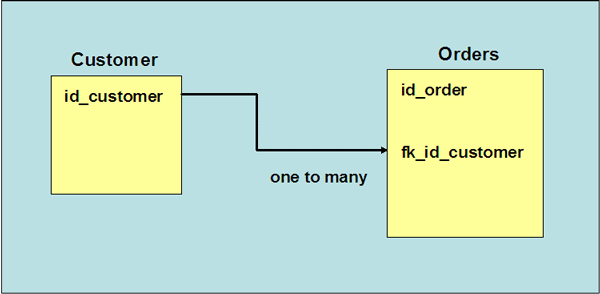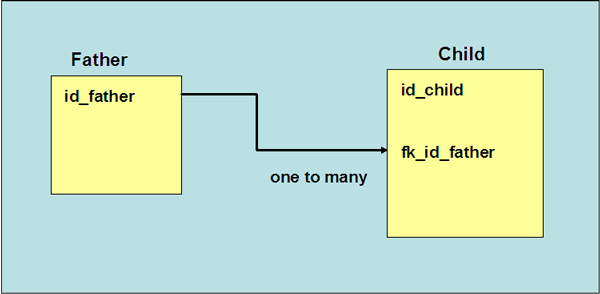
Some Discussion of HPM
PP106 - 117
Keys and Relationships
|
Keys and Foreign Keys. A key in a table is a unique identifier associated with each record. A table can have more than one key, and one of these needs to identified as the primary key. Some examples of keys are
When a key from one table is used in another table to link back to information in the table where it is a key, the key that appears in the other table is called a foreign key. It is foreign to the table it is in, but it is a unique identifier or link back to data in the other table. This can save repeating a lot of information. One-to-Many Relationships. These sorts of relationships between tables exist when the key of a record in one table, often called the parent table, can appear many times in the child table where it is used as a foreign key.
|

The diagram represents how information about the
customer that placed a particular order can be obtained from using
the foreign key for the customer fk_id_customer and the record it
points to in the Customer table. Because each customer can
place many orders, the relationship is said to be
one-to-many.
|

|
Father
|
Child
|
| So you can find out the name and birth city, or
any other information in the table, about the father of the child by
using the foreign key, fk_id_father as the key in the Father table. This sort of relationship is also called a parent table with the child table when used in general. One-to-One Relationships. When the key used in the parent table will appear exactly once in the child table you are said to have a one-to-one relationship. This relationship doesn't always have to exist. But if it does then there can be at most one connection for each record. One of the most obvious of these might arise in an employee and spouse table. This could be useful for medical benefits or a number of other reasons. Rather than draw a relationship connection I am going to illustrate this with two tables. |
|
Employee
|
Spouse
|
| Many-to-One
Relationships. Many people call these table lookup
relationships. It probably will be interesting to see if you
can come up with a Many-to-One Relationship that can't be considered
a table lookup. Consider the following situation. |
|
Employee
|
Location
|
| It is pretty reasonable to think of other
situations where this sort of setup can help save a lot of space and
repeated information. For example, you might have a list of
employees of other firms that are currently working on your site in
a consortium. Rather than list the complete address for each
employee's workplace, you have a single table that has all the
background information on each company in the consortium. Then
you can have some sort of field in each person's record that has a
single reference to their firm. Hopefully, it is getting easier to think of other many-to-one relationships. Many-to-Many Relationships. These sorts of situations arise quite frequently. Think of people and the organizations they belong to. My development of this will make use of three tables to ensure that everything has meaning. It is not uncommon to use this sort of middle association table to interconnect records. |
|
Residents
|
Memberships
|
Organizations
|
| So the many-to-many relationship that I want to
focus on is between Residents and Memberships. Notice how the
records aren't necessarily in order. These sorts of association tables such as this Memberships table really do arise in a number of ways. They can be a bit frustrating to work with. In even standard e-commerce web databases I have seen them used to associate products with departments. I have also seen them used to associate products with their attributes such as available colors and sizes. Cardinality. So we have four basic types of relationship pairings.
Over time I will develop more examples. But now we need to define a few more concepts. The minimum cardinality of a relationship is the minimum number of instances of entity B that must be associated with each instance of entity A. Most of the time this will be 0. But, for example, if your A entity is parents and your B entity is children, then the minimum cardinality must be one, otherwise they couldn't be parents. The maximum cardinality of a relationship is the maximum number of entity instances B that may be associated with each instance of A. Most of the time this will be unlimited. For example, each customer can place as many orders as they want, or each set of parents can have as many children as they want. But maybe you live in a country that is limiting the number of children each set of parents can have. Or maybe you can only use the ATM up to three times each month. Modeling Time Dependent Data. When teaching at Quinnipiac we had quite a few students that worked for Sikorsky. They were usually working on some sort of government projects that required a lot of recording of the history of the changes and developments on their projects. They would usually use time stamps associated with particular data to make sure they could reconstruct what has happened over time. One might also do something like change which products are contained in a product line and/or change their prices over time. In order to compute things like annual sales figures for product lines you need to be able to reconstruct prices and which products were in the line at different times. |